RICHMOND FEN VIA JOY'S ROAD
Spring: **** Summer: **** Fall: *** Winter:**
Warning: The Richmond Fen is accessible via the railroad tracks, and these tracks have recently been posted with warning signs. The railway right-of-way is private property, and the train is fast, quiet and deadly. That being said, authorities seem to take a benign view of birders visiting the fen. On the Richmond Fen from the North end, you might want to park well away from the rail crossing, however, or you may find yourself followed by a curious police officer looking for trouble-makers. The Richmond Fen via Kettles Road access (somewhat less walking distance) is much less likely to attract such attention and is the most frequently used way into the fen. The third alternative, though not for everyone, is this one, the Richmond Fen via Joy's Road canoe-only access route. This may allow access without infringing on the railway property, depending on beaver dams and the like.
Independent Directions to this Site: From Highway 416 take exit 66 (Fallowfield Road). If southbound, a 0.4 km offramp dumps onto Fallowfield, where you will turn right or west. If northbound, the 0.4 km offramp brings you to Fallowfield, where you will turn left or west onto it and in 0.5 km join the southbound offramp traffic. Both groups will now follow Fallowfield Road west 4.5 km to reach Eagleson Road. Turn left or SSE onto Eagleson Road and drive 5.4 km to Perth Street / Richmond Road. Turn right or southwest on Perth Street and proceed through Richmond to Joy's Road (formerly Joy's Side Road), a distance of 3.7 km. Turn left or southeast onto Joy's and go 1.4 km to Ottawa Street, then turn right or southwest on Ottawa and proceed 0.1 km to where Joy's Road continues to the left or southeast. Take Joy's Road 0.9 km, past the golf course, to as close as you can get to the Jock River. Beyond the golf club the road deteriorates and the last 100 metres may be impassable, especially after a rain. The river access here, such as it is, is the Richmond Fen via Joy's Road canoe-only access route.
Marlborough Forest Loop Route Directions: From wherever you are on Conley Road, continue southeast to Franktown Road (0.2 km beyond where the trees end). Turn left or northeast on Franktown and drive 3.1 km to Joy's Road (formerly Joy's Side Road). Turn right or southeast onto it and go 1.4 km to Ottawa Street, then turn right or southwest on Ottawa and proceed 0.1 km to where Joy's Road continues to the left or southeast. Take Joy's Road 0.9 km, past the golf course, to as close as you can get to the Jock River. Beyond the golf club the road deteriorates and the last 100 metres may be impassable, especially after a rain. The river access here, such as it is, is the Richmond Fen via Joy's Road canoe-only access route.
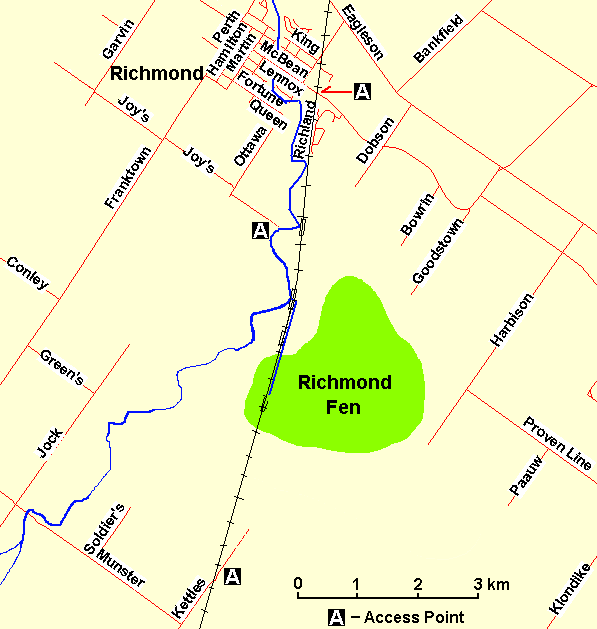 Map of the Richmond Fen Area
Map of the Richmond Fen Area
Site Description and Birding Information: It is 7.8 km along the tracks between the two road accesses for the Richmond Fen. This makes it a fairly long walk (which is often birdy), 6.8 km return from the Richmond Fen via Kettles Road access to the southwest (the preferred way) and 8.8 km return from the Richmond Fen from the North access on McBean Street in Richmond. This site is offered as an alterative for those not up to the sometimes arduous hike along the tracks. However, a canoe or equivalent is necessary. It is also important to have a good light for nocturnal visits.
This route is considerably shorter. Only 0.8 km upstream or south by canoe to a channel to the left that goes to a small railway bridge. The river here is not difficult to navigate and usually not too swift, especially toward summer. The 800 metres of the Jock River here are worth visiting on their own. Not only is this stretch very beautiful, it can be very exciting birdwise, especially in migration. There are sections of slower moving water that have marsh vegetation growing in or along them. Great Blue Heron come here for quiet fishing spots.
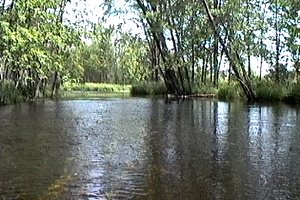
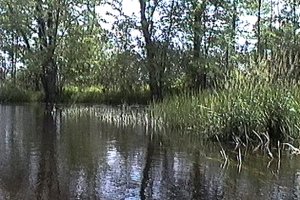 The Beautiful Jock River between Joy's Road and the Richmond Fen
The Beautiful Jock River between Joy's Road and the Richmond Fen
The narrow channel, blocked by beavers or driftwood, goes under the upstream bridge. You can do one of two things here. You could lift the canoe over the blockage and into the canal or ditch that then parallels the tracks into the fen on their east side. This channel has not been tested, but looks usable. The other method, better for those in a hurry - such as Big Day participants, is to ground the canoe by the bridge and walk the tracks about a kilometre into the fen. The bridge is close to the edge of the woods.
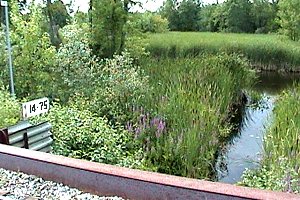 Channel at the Railway Bridge along the Jock River
Channel at the Railway Bridge along the Jock River
|
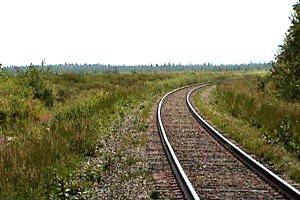 Looking toward the Fen from the Railway Bridge
Looking toward the Fen from the Railway Bridge
|
The Richmond Fen is a "must" pilgrimage for birders in the Ottawa area. It is a unique and significant wetland and is home to the only known breeding colony of Yellow Rail in our area. The hike or paddle from here, along or alongside the tracks, into the fen is around one kilometre.
Between the 15 and 15.25 markers, is the heart of the fen, where Yellow Rails (up to 10 ticking in exceptional years) and Sedge Wrens (up to 30 singing in exceptional years) hold forth in May and June. American and Least Bittern, Northern Harrier, Virginia Rail, Sora, Marsh Wren, Alder and Willow Flycatcher and Swamp Sparrow are breeders here. Rarities that have shown up here include: Sharp-tailed Sparrow (Jun. 12, 1993).
Coming in by daylight, staying until after dark, then going back out is one strategy. Another is to come in the early morning darkness, then go back out catching the dawn chorus. Big Day listers often come in before midnight, tick off the night birds and rush out and off to their next site.
 View of the Richmond Fen
View of the Richmond Fen
If you are up for more hiiking from here, the woodland edge along the tracks on either side of the fen can be very birdy during migration. It passes through mixed, and often wet, woodland with good visibility from the rail bed. Watch closely at the edge of the woodland on entering the fen, this transition habitat is often very productive. It is a great place to find boreal forest migrants such as Canada (who breed) and Blackpoll Warbler or Yellow-bellied Flycatcher. The woods to the southwest are prime owling territory. A Great Horned Owl has sometimes nested in one of the large pines, while Northern Saw-whet Owl has often been heard and seen along the tracks here. Barred and Long-eared Owls have also been heard.
One more alternative exists here. Back at the Joy's Road "boat landing", you could opt to go downstream or southeast along the Jock River for somewhat less than 300 metres to the railway bridge visible from this point. Park your canoe at this bridge and walk the tracks about 1.7 km into the fen. This entails 0.7 km extra on foot each way, but 0.5 km less by canoe each way, than the upstream option.
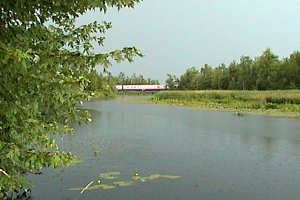 Train Crossing Bridge Downstream from Joy's Road Landing
Train Crossing Bridge Downstream from Joy's Road Landing
Marlborough Forest Loop Route Directions: This is the last site on this loop. From here you can visit some of the Stony Swamp Loop sites nearby such as the Shea & Akins Roads or Rushmore Road sites to the north, or the Twin Elm, Burnside Pits or Nepean Dump sites to the northeast. To return to Ottawa, retrace your route to the Franktown Road or Perth Street, turn right or northeast and drive 3.7 km to Eagleson Road. Turn left or NNW on Eagleson and go 5.4 km to Fallowfield Road. Turn right or northeast onto it and proceed 5.0 km to Highway 416. Pass over the highway to the onramp on the right just beyond. Follow it around 270 degrees to join Highway 416 northbound to Ottawa. It reaches Highway 417 in 8.6 km, where you will turn east toward downtown or west toward Kanata.
Return to Marlborough Forest Loop
Return to Birding Ottawa Table of Contents
|






